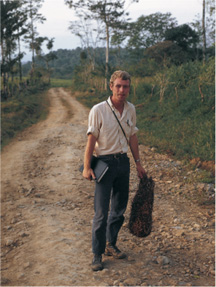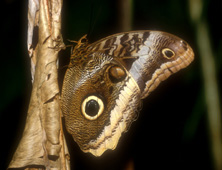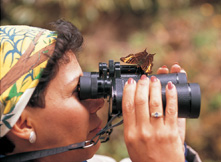
I grew up as a farm boy near Zearing in central Iowa, and most of my early travels were within twenty-five miles of our family farm. I had quite a provincial view of life and no concept of ecosystems, biological diversity, or tropical rainforests. I just knew that I loved wildlife. I had no idea that Costa Rica, a small country thousands of miles away in Central America, would later play such a dramatic role in shaping the direction of my personal and professional life.
An early and enthusiastic interest in nature led me to major in zoology and minor in botany at Iowa State University. After completing my bachelor’s degree at ISU in 1968, I enrolled in graduate school at the University of Georgia, where I studied ecology, forest and wildlife management, journalism, and public relations. During my search for a thesis topic, Dr. James H. Jenkins directed me to an Organization for Tropical Studies (OTS) course in Costa Rica.
When I began my two-month OTS course in tropical grasslands agriculture in February of 1969, I had no idea it would be such a life-changing experience. Every day was an adventure! I tried to absorb all that I could about the land, the people, and the wildlife of Costa Rica. I quickly learned that this is not a country you can visit just once. By March I had already applied for another OTS course and was subsequently accepted. In June 1969, I drove from Georgia to Costa Rica with Dr. Jenkins for an OTS course in tropical ecology.

The author with an oropendola nest during an OTS course in Costa Rica, 1969.
The OTS faculty, recruited from educational institutions throughout North and Central America, included some of the most notable tropical biologists in the world. They inspired me with their knowledge and enthusiasm about tropical ecosystems. By the end of the tropical ecology course, I had fallen in love with the country, with its people, and with Ethelle González Alvarez, a student at the University of Costa Rica. I returned to Costa Rica a third time in 1969. Ethelle and I were married in December of that year and have now been married forty years. We have a son, Craig, who shares our love and enthusiasm for his Tico heritage, along with his wife, Reem, and son, Mazen Nathaniel.
After returning to the University of Georgia, I wrote my master’s thesis, “Fish and Wildlife Resources of Costa Rica, with Notes on Human Influences.” The 340-page thesis analyzed human influences that were having significant positive or negative impacts on Costa Rica’s wildlife. I also provided recommendations for changes in the game laws that would improve management of the country’s wildlife.
In addition to my interest in vertebrates, I had previously studied entomology at Iowa State University and did a National Science Foundation undergraduate research project on mosquitoes under entomologist Dr. Kenneth L. Knight.
During the forty years since my first visit to Costa Rica, I have returned forty-one times. Since 1987, our visits to the country have included leading wildlife tours. Ethelle and I have led twenty-six birding and wildlife tours to Costa Rica since 1987 in coordination with Preferred Adventures Ltd. of St. Paul. We continue to see new species on every visit—and every day is still an adventure!
Each year thousands of first-time tourists are experiencing the same sense of wonder about the country’s rainforests and wildlife that I did in 1969, and Costa Rica has become one of the top nature tourism destinations in the world. This book is written to share my enthusiasm and knowledge about the country’s wildlife with those tourists and with Costa Ricans who share our love of nature. It is written to answer questions about identification, distribution, natural history, and the incredible ecological adaptations of many wildlife species. It also provides the opportunity to recognize the people and conservation programs that have made Costa Rica a world leader in preserving its tropical forest and wildlife resources. This is not a typical field guide. It includes selected species of butterflies, moths, and other invertebrates that are likely to catch the attention of tourists in Costa Rica because of their conspicuous colors, size, or unique life histories. It does not cover the invertebrates comprehensively, but it will assist in identifying many of the more common creatures that are likely to be encountered during a visit at the peak of the annual tourist season, from January through March.

Caligo atreus

Every day is an adventure in Costa Rica.